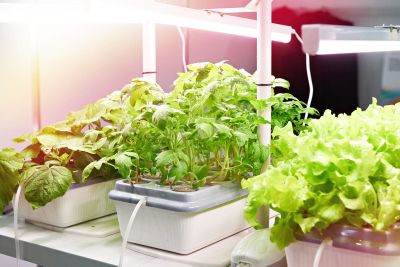What Do You Need for Hydroponics?
Plants require four things to survive and flourish – light, a substrate in which to grow, water, and nutrients. Let’s take a look at the basic hydroponic equipment you’ll need to supply all four key elements:
Light
Sunlight provides the full spectrum of visible and non-visible light. It’s not only the cheapest, but also the best way to provide light for hydroponics. Many vegetable plants require a minimum of six hours of direct light per day. Southern-facing windows and greenhouses have the potential to provide this amount of sunlight. The alternative is the use of grow lights. Bulbs with an output in the range of 4,000 to 6,000 Kelvin will provide both warm (red) and cool (blue) light. When using artificial light, additional hydroponic tools and equipment are needed. These include light fixtures, structural support for lighting, power strips, and accessible outlets.
Substrate
Since hydroponics does not use soil, plants require an alternate substrate for support. Like soil, substrate materials hold water, air, and nutrients plants need for growth. Substrates can be natural materials like coconut fiber, pea gravel, sand, sawdust, peat moss, perlite, and vermiculite. Or they can be man-made products such as rockwool or expanded clay pellets.
Water
Reverse osmosis (RO) water is the preferred choice for hydroponic systems. This purification process provides water which is 98-99% pure. The purer the water, the easier it will be to keep plant nutrients in the correct balance. You’ll also need additional hydroponic tools to monitor water pH.
Nutrients
Plants require several key micro and macro nutrients. These include:
Nitrogen
Potassium
Phosphorus
Calcium
Magnesium
Sulfur
Iron
Manganese
Copper
Zinc
Molybdate
Boron
Chlorine
Many hydroponic gardeners prefer to buy a hydroponic premix which contains these nutrients in the correct balance. Fertilizer designed for soil won’t contain all of the above nutrients and can lead to deficiencies. Additional equipment for hydroponics includes a total dissolved solids (TDS) meter to measure the strength of the hydroponic solution.
Types of Hydroponic Systems
Additionally, hydroponic gardeners need a basic system to hold everything together. The six types of hydroponic systems primarily differ in how they supply water and nutrients to the plants. Some systems work better with different types of plants than others. Gardeners can purchase systems as ready-made units or as kits. If you decide to build your own system from scratch, you’ll need a reservoir container, net pots, and these additional hydroponic tools and equipment:
Wick System – Grow tray, rope wicks, air stone, non-submersible air pump, and air hose.
Water Culture – Water culture uses a floating platform, non-submersible air pump, air stone, and an air hose.
Ebb and Flow – Grow tray, overflow tube, submersible air pump, timer, and air hose.
Drip System – Grow tray, drip manifold, drip lines, overflow tube, submersible pump, timer, non-submersible air pump, stone, and air hose.
Nutrient Film Technique – Grow tray, overflow tube, submersible pump, non-submersible air pump, air stone, and air hose.
Aeroponics – Aeroponics uses a submersible pump, short-cycle timer, air hose, and mist nozzles.
